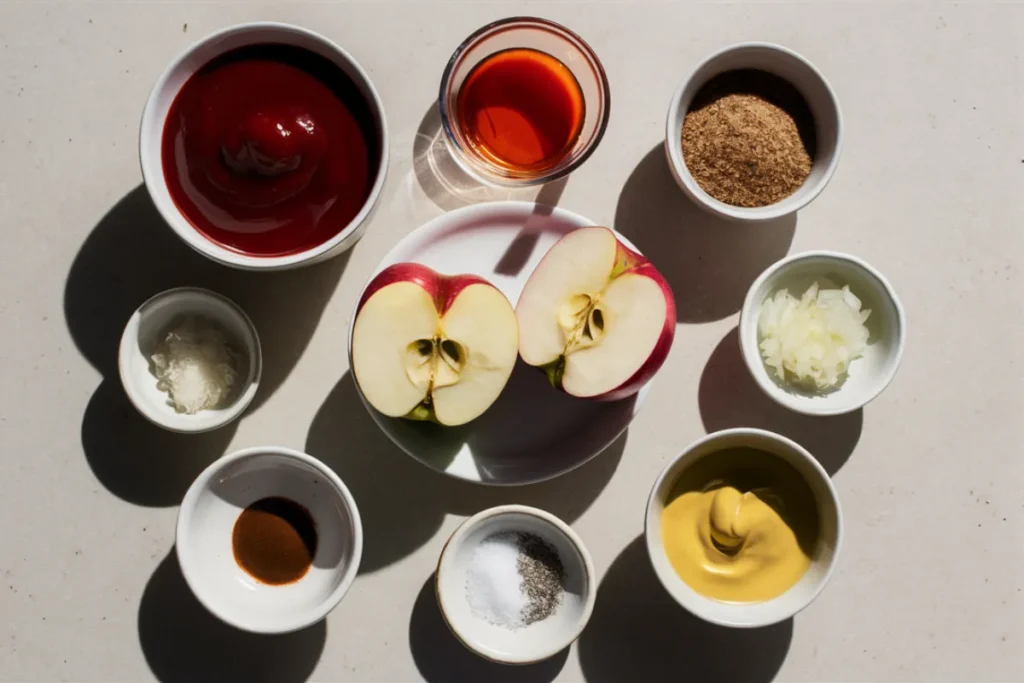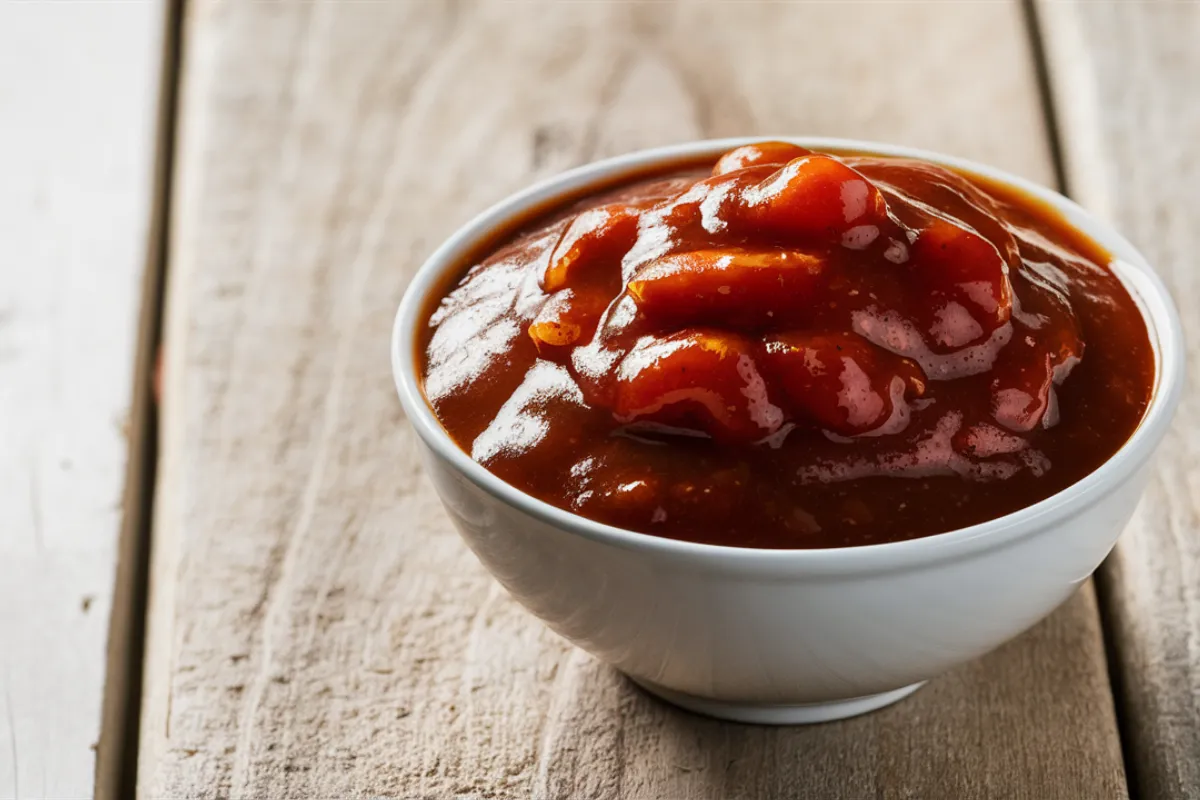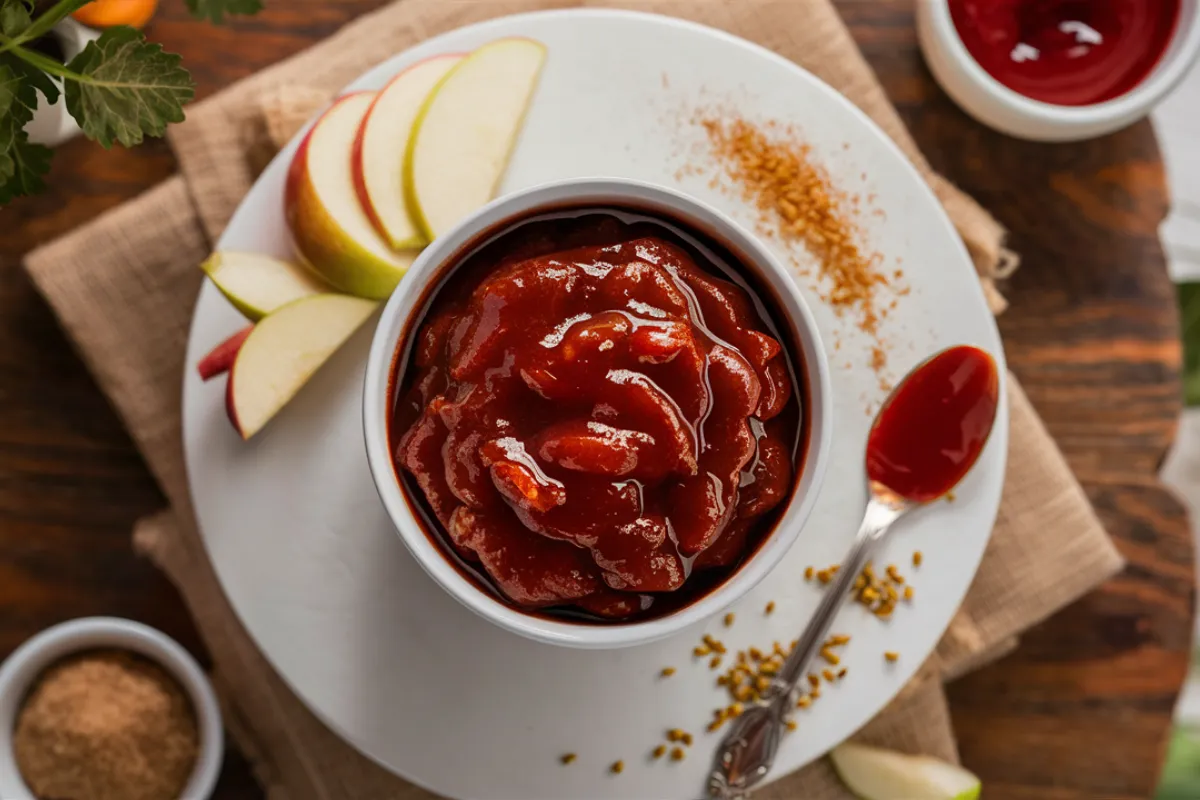Apple BBQ sauce is a delightful blend of sweet, tangy, and smoky flavors, perfect for complementing a variety of dishes. The sweetness from the apples paired with the depth of barbecue sauce creates a unique and flavorful condiment that can elevate any meal. Whether you’re looking for a sauce to brush on grilled meats, use as a marinade, or serve as a dipping sauce, apple BBQ sauce brings something special to the table.
Ingredients for Apple BBQ Sauce

The ingredients in apple BBQ sauce are carefully chosen to balance flavors and create a versatile, delicious sauce. Each ingredient plays an important role in building the sweet, tangy, and smoky notes. Below is a breakdown of each ingredient and its role in the recipe, along with possible substitutions for those who want to experiment with different flavors.
- Fresh Apples (2 medium, peeled, cored, and chopped)
Role in Recipe: Apples bring natural sweetness, balanced by the tanginess of other ingredients, while adding texture and body.
Substitutions: If fresh apples aren’t available, substitute with applesauce. Alternatively, use pears or peaches for a different flavor profile. - Ketchup (1 cup)
Role in Recipe: Ketchup serves as the base, providing tomato flavor and sweetness, while helping to thicken the sauce.
Substitutions: Use tomato paste mixed with sugar and vinegar if ketchup isn’t available. Adjust seasonings as needed.
3. Apple Cider Vinegar (½ cup)
- Role in Recipe: Apple cider vinegar provides acidity, balancing the sweetness from the apples and ketchup. It also enhances the tanginess of the sauce.
- Substitutions: White vinegar or rice vinegar can be used, though the flavor will be slightly different. Lemon juice can also be substituted for a less intense acidity.
4. Brown Sugar (½ cup)
Role in Recipe: Brown sugar adds sweetness and depth to the sauce, helping to balance the acidity from the vinegar and the savory notes from the spices.
Substitutions: Honey or maple syrup can be used instead of brown sugar, though they will slightly alter the flavor of the sauce.
5. Onion (1 small, finely chopped)
- Role in Recipe: Onion adds a savory depth to the sauce and complements the sweetness of the apples and sugar. It also helps thicken the sauce as it cooks.
- Substitutions: Shallots can be used for a milder flavor, or onion powder can be used if fresh onions are unavailable.
6. Garlic (2 cloves, minced)
- Role in Recipe: Garlic brings an aromatic, savory element to the sauce, enhancing its overall flavor.
- Substitutions: Garlic powder can be used in place of fresh garlic, though fresh garlic will provide a more robust flavor.
7. Worcestershire Sauce (2 tbsp)
- Role in Recipe: Worcestershire sauce adds umami and complexity to the sauce, contributing to its savory notes and enhancing the overall barbecue flavor.
- Substitutions: Soy sauce or tamari can be used as a substitute for Worcestershire sauce, though they may change the flavor slightly.
8. Smoked Paprika (1 tbsp)
- Role in Recipe: Smoked paprika adds a smoky flavor to the sauce without the need for liquid smoke. It enhances the barbecue flavor and adds warmth.
- Substitutions: Regular paprika can be used if you prefer a milder flavor, though you will lose the smokiness. A small amount of chipotle powder can be added for extra heat and smokiness.
9. Yellow Mustard (2 tbsp)
- Role in Recipe: Mustard adds a tangy sharpness that helps to balance the sweetness from the apples and sugar.
- Substitutions: Dijon mustard or whole grain mustard can be used for a different flavor profile. You can also reduce the amount of mustard for a milder tang.
10. Salt and Pepper (to taste)
- Role in Recipe: Salt and pepper are essential for seasoning the sauce and balancing the sweetness and tanginess of the other ingredients.
- Substitutions: Sea salt or kosher salt can be used instead of table salt. For a more complex heat, you can experiment with different types of pepper, such as white or cayenne pepper.
Step-by-Step Guide to Making Apple BBQ Sauce
Below is a comprehensive guide to preparing apple BBQ sauce from scratch. Follow these steps to ensure your sauce turns out flavorful, tangy, and perfect for any dish.
Step 1: Preparing Ingredients for Apple BBQ Sauce
- Peel and Chop the Apples: Start by peeling and coring the apples, then chop them into small, even pieces. The smaller the pieces, the faster they will cook down and blend into the sauce.
- Chop the Onion and Mince the Garlic: Prepare the onion and garlic by finely chopping them. This will help them incorporate more easily into the sauce and add flavor.
2: Sautéing Aromatics for Apple BBQ Sauce
- Heat Oil in a Saucepan: In a medium-sized saucepan, heat a tablespoon of oil over medium heat. Once the oil is hot, add the chopped onions and cook until they become soft and translucent, about 5 minutes.
- Add Garlic and Apples: Add the minced garlic and chopped apples to the onions and cook for another 3-5 minutes, until the apples begin to soften.
3: Building the Flavorful Base for Apple BBQ Sauce
- Add Ketchup and Vinegar: Stir in the ketchup and apple cider vinegar. This will form the base of your sauce, providing both sweetness and acidity.
- Incorporate the Sugar and Spices: Add the brown sugar, Worcestershire sauce, smoked paprika, mustard, salt, and pepper. Stir well to ensure all ingredients are combined evenly.
4: Simmering and Cooking Apple BBQ Sauce to Perfection
- Bring to a Simmer: Allow the mixture to come to a gentle simmer over medium-low heat. Once it reaches a simmer, reduce the heat to low and let the sauce cook for 25-30 minutes, stirring occasionally. This slow cooking process will allow the flavors to meld and develop.
- Check the Consistency: As the sauce simmers, it will thicken and the apples will break down. If the sauce becomes too thick, you can add a little water or apple juice to thin it out to your desired consistency.
5: Blending Apple BBQ Sauce for Smooth Texture
- Blend for Smoothness: Once the sauce has finished simmering and the apples have broken down, remove it from the heat. Use an immersion blender to blend the sauce until it is smooth. If you prefer a chunkier texture, you can skip this step or only blend partially.
- Taste and Adjust Seasoning: After blending, taste the sauce and adjust the seasoning if needed. You may want to add more salt, pepper, or brown sugar depending on your preference.
6: Storing and Serving Apple BBQ Sauce for Best Results
- Cool and Store the Sauce: Allow the sauce to cool to room temperature before transferring it to an airtight container. Store the sauce in the refrigerator for up to two weeks or freeze it for longer storage.
- Serve with Your Favorite Dishes: Apple BBQ sauce is perfect for grilled meats like chicken, pork, or beef, but it’s also great as a dipping sauce for fries, roasted vegetables, or even as a topping for sandwiches and burgers.
Tips for Achieving the Best Apple BBQ Sauce

Creating the perfect apple BBQ sauce requires a few key tips to ensure you get the best flavor and texture every time. Follow these tips to make your sauce stand out.
Tip 1: Use Sweet and Tart Apples
Choosing the right type of apples will make a difference in the flavor of your sauce. Sweet apples like Gala or Honeycrisp will add more natural sweetness, while tart apples like Granny Smith will give the sauce a tangier bite. Using a combination of both can create a balanced sauce.
Tip 2: Taste as You Cook
BBQ sauce is all about balance, so be sure to taste your sauce as it cooks. You can adjust the sweetness, acidity, or smokiness depending on your personal preferences. If the sauce is too sweet, add more vinegar or mustard; if it’s too tangy, add more sugar.
Tip 3: Simmer for Depth of Flavor
Allowing the sauce to simmer for an extended period helps the flavors develop and intensify. The longer it cooks, the deeper and more complex the flavors will become. Be patient and let the sauce simmer until it reaches the desired richness.
Tip 4: Blend for a Smooth Texture
Blending the sauce gives it a smooth, velvety consistency. If you prefer a chunkier texture, you can blend the sauce only partially or leave it as is. An immersion blender makes this step easy and quick.
Frequently Asked Questions (FAQs)
1. Can I make apple BBQ sauce ahead of time?
Yes, apple BBQ sauce can be made ahead of time and stored in the refrigerator for up to two weeks. This makes it convenient for meal prep or for having on hand for future meals.
2. What kind of apples are best for this recipe?
You can use any apples you like, but a mix of sweet and tart varieties like Honeycrisp and Granny Smith will give the sauce a balanced flavor. Sweet apples will make the sauce sweeter, while tart apples will add a bit of tang.
3. Can I freeze apple BBQ sauce?
Yes, apple BBQ sauce freezes well. Simply transfer the cooled sauce to an airtight container or freezer bag and freeze for up to three months. Thaw the sauce in the refrigerator before reheating.
4. Can I use apple juice instead of fresh apples?
You can use apple juice, but fresh apples give the sauce more texture and depth of flavor. If you choose to use apple juice, reduce the amount of sugar in the recipe since apple juice is already sweet.
5. Is this sauce gluten-free?
Yes, apple BBQ sauce is naturally gluten-free, provided you use gluten-free Worcestershire sauce or tamari. Always double-check labels to ensure there are no hidden gluten ingredients.
6. How can I make this sauce spicier?
If you prefer a spicier apple BBQ sauce, you can add crushed red pepper flakes, cayenne pepper, or even a splash of hot sauce. Adjust the amount of heat to your preference.
7. Can I use this sauce as a marinade?
Absolutely! Apple BBQ sauce works wonderfully as a marinade for meats like chicken, pork, or beef. Simply coat the meat with the sauce and let it marinate for at least 30 minutes before grilling or roasting.
8. Can I add other spices to the sauce?
Yes, feel free to experiment with other spices like cumin, chili powder, or ginger to customize the flavor of the sauce to your liking. Just be mindful of the balance between sweet, tangy, and smoky flavors.
9. What dishes pair best with apple BBQ sauce?
Apple BBQ sauce pairs wonderfully with grilled or smoked meats such as chicken, pork ribs, and beef brisket. It also works well as a dipping sauce for roasted vegetables, fries, or even as a topping for burgers and sandwiches.
Conclusion
Apple BBQ sauce offers versatility and flavor, adding a unique twist to traditional barbecue sauces. Its sweet, tangy, and smoky notes elevate a wide range of dishes, from grilled meats to roasted vegetables. The combination of apples, brown sugar, and vinegar creates a balanced flavor, making it perfect for marinating, dipping, or glazing. Whether you host a summer barbecue or want to enhance your meals in a new way, apple BBQ sauce delivers a delicious and easy-to-make option that impresses every time.

